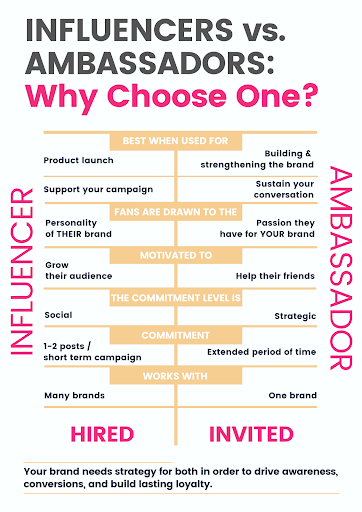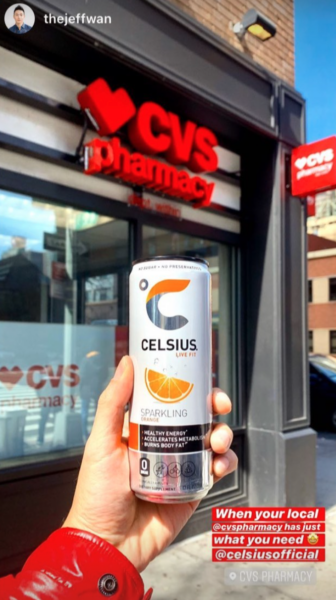Ambassador marketing is not only about making a celebrity the face of your brand. Although, the media might have made some people believe it is.
In reality, celebrity endorsements are not the main goal of ambassador marketing. On the contrary. Ambassador marketing is all about making people that love your brand, like your customers or employees, the face of your brand.
You could say ambassador marketing is a more authentic version of influencer marketing combined with experiential marketing. That sounds a little weird, but trust us, it works.
In this article, we will explain what exactly is ambassador marketing, who can be an ambassador, the benefits of ambassador marketing, how it works, and your next steps.
Let’s start with the definition.
What is ambassador marketing?
Ambassador marketing is a type of marketing strategy that uses customers, employees, or any type of influencer to endorse and represent a brand through online and in-person activities.
Ambassador marketing works because people trust others for brand recommendations more than ads, especially people they know.
90% of people believe brand recommendations from friends, while only 25% accept ads as truth.
So when a friend uses or talks about a product, you trust it because he or she is vouching for it. In a way, that validates the product or service.
In addition, this type of marketing feels a lot more authentic to people because you are collaborating with people who truly love your brand. Not someone pretending.
Ambassador marketing vs influencer marketing
The main misconception about ambassador marketing is that it’s the same thing as influencer marketing. However, there are key differences.
The first difference is that influencer marketing focuses on short-term campaigns. Usually, one or two pieces of social media content, then the influencer gets paid, and that’s the end of the collaboration.
For these campaigns, the influencers are selected based on their reach, engagement, and target audience. Most of the time, the influencer can be unfamiliar with the product, since their main objective is to only bring awareness to it.
On the other hand, ambassador marketing campaigns are meant to be long-term partnerships. Meaning that the ambassadors continuously participate in content creation and events.
Here, ambassadors are recruited based on their connection to the brand, their engagement, demographic, and reach. However, having a large social media following is not as important.
In fact, people with small followings have better engagement rates since they have a closer relationship with their followers. Which results in more conversions. So it’s in the best interest of brands to recruit these people.

So, who can be a brand ambassador?
The short answer is that you can select anyone to become a brand ambassador for your brand, as long as they are ideal for reaching your marketing goals.
The good thing about ambassador marketing is that it opens the door to marketing through normal people who love your brand. They don’t have to be celebrities with a large following.
The clearest example for this is: if your target market is college students, make students in target colleges your ambassadors.
So take a look at your customers, employees, and fans when you plan your ambassador program.
People with smaller followings are also typically called “micro-influencers” for obvious reasons. If you like to read about influencer marketing, you have probably heard a lot about them in recent years.
How can ambassador marketing help your brand?
As we mentioned before, people don’t trust ads as much anymore. So marketers are shifting to more authentic approaches to marketing. And who would be better for endorsing a brand than a fan?
With an ambassador program you can achieve the following things:
Increase brand awareness
Marketers might think that since normal people (or micro-influencers) don’t have massive followings they won’t be able to drive much awareness.
But that is not true.
While a single ambassador with 10,000 followers might not seem like much, 100 ambassadors with 10,000 followers add up to a reach of 1,000,000 people. Now consider that small influencers have higher engagement rates. Meaning that the awareness your ambassadors create will have a higher probability of converting.
Most successful ambassador programs have hundreds of members, so getting 100 ambassadors isn’t as difficult as you might think.
Increase sales/referrals/leads
Naturally, with increased awareness in target audiences and great content, leads and sales will follow. But you can also incentivize referrals by giving ambassadors the ability to earn commissions for the purchases they generate.
This strategy motivates ambassadors to refer more.
Build your community
Building your brand community has many benefits on its own. And brand ambassadors are great for growing it.
An engaged community needs new content and a lot of participation. Ambassadors contribute to the community and engage with it, bringing it to life. When people see an active community around the brand they like, they will be more motivated to participate.
You should definitely not overlook investing in your brand community. Especially considering that advanced communities see a 7,071% ROI.
Cost-effective digital marketing
Having an ambassador program with normal people isn’t as expensive as hiring celebrity influencers because most of the time, they will be happy with receiving free products or discounts.
After all, being an ambassador is an opportunity for them to be part of the brand they love and get exclusive rewards in the process.
If you choose to pay your ambassadors through commissions, then it’s even more cost effective since you would only be paying for conversions.
How does ambassador marketing work?
Let’s take a closer look at how an ambassador marketing campaign or program works.
Usually, an ambassador program looks like this.
1. Brand recruits ambassadors
First comes the recruiting. The most common methods for recruiting brand ambassadors are looking for candidates on social media, your customer base, employees, job postings, and reaching out directly. Or through an application form on your website where people can apply.
With either method, you can start slow by selecting a few people who really love your brand, and start scaling at a rate you are comfortable managing.
2. Brand onboards ambassadors
This just means that you provide the people that accepted being your brand ambassadors the right documentation to understand their role. You need to prepare these documents (content guidelines, tasks, a guide to any tools, etc.) beforehand so there is no confusion.
3. Ambassadors do online or in-person tasks
Then comes the tasks. The main activity that brand ambassadors participate in is the creation of social media content. Simple content that feels authentic to the creator is the best way to go.
For example, if a brand is opening a new store location, they can reward the ambassadors for visiting it and posting an Instagram story about it.

If multiple ambassadors do this, now all their networks combined know about the new store.
Some ambassador marketing programs include in-person activities such as hosting events/classes or giving out flyers. These activities are great for hyperlocal marketing campaigns.
Depending on the program you are running, you can assign the tasks or ambassadors can have the freedom to choose their own tasks.
4. Brand ambassadors get rewarded
Then, the ambassadors get rewarded for their tasks. The compensation method is up to you, and you can even combine different payments. The most common compensation methods are:
- Free products (monthly products package)
- Discounts
- Cash payment
- Commissions
Your next steps
Now, it’s time to start planning your program. To do this, you will first need to decide which type of strategy you would like to follow:
- Gamified ambassador program
- Affiliate ambassador program
- Student ambassador program
- Employee ambassador program
- Informal ambassador program
- Combined ambassador marketing strategy
Then, you will have to follow these steps to start your program:
- Define your goals
- Create guidelines
- Find and recruit the right brand ambassadors
- Train and onboard your brand ambassadors
- Reward your brand ambassadors
- Track your brand ambassadors’ performance
- Scale
This post was originally published here.
Digital & Social Articles on Business 2 Community
(44)
Report Post







